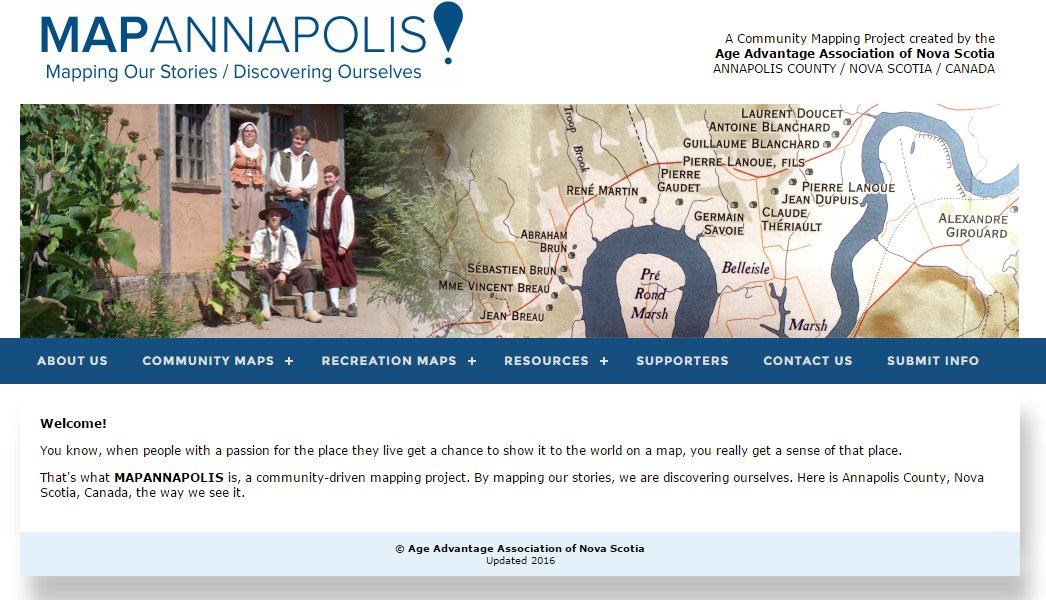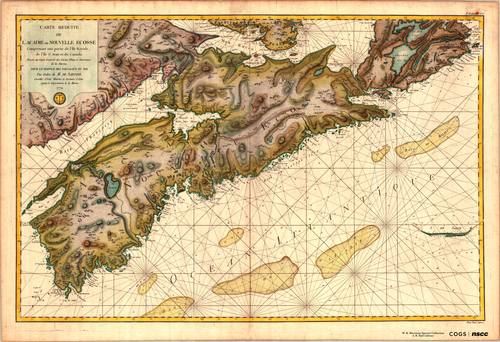Today (April 7), I attended the Community Mapping Showcase at the Centre of Geographic Sciences (COGS).
Maps Tell the Stories We Choose to Tell
This project is a collaboration between the Age Advantage Association (AAA), a not for profit group of senior (elders) in the Annapolis Valley and the instructors and students in the Diploma of Geographic Sciences, Community and Environmental Planning program. Key contacts are Heather Leblanc (AAA) and Ed Symons and Monica Lloyd (NSCC). The interactive web-based maps are delivered both through Esri ArcGIS Online and Google Maps. Check out the web site at www.mapannapolis.ca

This inter-generational project allows seniors to bring their local knowledge of the landscape to the map, and COGS students to bring their GIS and cartographic expertise to the table.

Specific maps for the Annapolis Valley include:
- historic homes/ cemeteries
- wharves,churches,trails
- black loyalist/ Acadian home sites
- cultural assets
- Bear River artisans
- The most recent innovation is the creation of an online form which allows community members to propose and add additional features to the geographic database.
As part of the showcase, Trish LeBlanc from the COGS Map Library provided a tour of the Walter Morrison collection of historic maps. This Collection was donated to NSCC COGS by Walter Morrison, Cartographer Emeritus of COGS who was interested in antique maps as an illustration of the evolution of map making technology. It is a mixed media print collection of over 2000 historical maps, atlases, periodicals and books that is focused on the early mapping of Atlantic Canada and specifically Nova Scotia.
Here, cartography students can compare maps of the early settlements with their present representation. http://bit.ly/COGSmaps
Where to go from here ?
Currently, the community mapping project is hosted using the technology available at the college. It offers a rich and eclectic view of the cultural landscape. Much of it based on a series of maps commissioned by Annapolis Ventures ' Cemeteries, Graveyards and Burying Grounds in Annapolis County' n.d.. If these online community maps are to be used for Community Planning, then it will be important for the technology to remain current. To address these concerns, there will need to be agreements about ownership of the data, quality control and access for decision - making purposes.
The community mapping project is an excellent initiative which uses the skills and interests of the local residents , and links to the GIS at the college. To be sustainable, it likely requires its own portal, with appropriate access rights for the different 'communities of interest'.
Modern web GIS facilitates this type of collaboration, where local connects with global. The Annapolis Valley has a wonderful resource at COGS, which can help address deeper conversations about the creative rural economic (Greg Baeker) and place-based education (David Gruenewald and Gregory Smith).
There are a number of similar initiatives happening in other parts of rural Canada. For example, Vancouver Island (www.whereishereculturalmapping.com).

In conclusion, in the words of Map Annapolis :
'"Community- created asset maps are based on the premise that local residents possess expert knowledge of their local environment which can be expressed in a geographic framework which is easily understandable and universally recognized. Participatory maps often represent a socially or culturally distinct understanding of landscape and include information that is excluded from mainstream.
References
Greg Baeker. Rediscovering the Wealth of Places: a municipal cultural planning handbook for Canadian communities. Published by Municipal World.
David A. Gruenewald and Gregory Smith (ed.) 2008. Place-based Education in the Global Age. Taylor and Francis.
About the author
Bob Maher is a Geographer, living in Paradise, Nova Scotia. In the 1980's he designed, developed and delivered a number of intensive computer programming programs at COGS. In 2000, he returned as Senior Research Scientist at the Applied Geomatics Research Group until his retirement in 2011. He has worked closely with the Geomatics industry for over thirty years.
